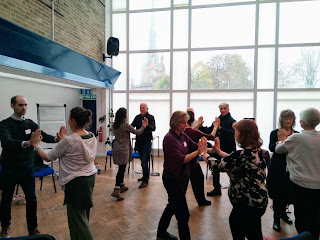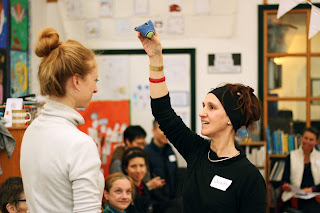Review of the Alexander in Education Foundation Course by Kate Minogue
 |
| Kate Minogue as Tall’n’Soft Tallulah! |
The programme was devised by Judith Kleinman and Sue Merry.
Judith teaches at the Royal College of Music and the Junior Academy of Music.
She co-ordinates the STAT Education Special Interest group and is working and
collaborating on taking Alexander work into secondary schools. Sue has been
finding unique ways of working with primary school children since 1994 and is a
founder member of Educare Small School where AT is integrated into the school
day.
The course was open to teachers, as well as ninth-term
students, and previous experience of working with children and young adults was
not required. Participants came from around the UK as well as the USA, Denmark,
Austria, and France.
During the first weekend (October 2016) we looked at how to
structure a preliminary INSET day for teachers as well as the initial session
with the pupils that we hope might follow from such an INSET day. We took a
brief look at school and national curricula, examining how we could link an AT
programme to them. It seems clear that AT is uniquely appropriate to helping
pupils learn to master fundamental movement skills and to understand that mind
and body are connected. Such skills permit children to read their environment
and make appropriate decisions, allowing them to move confidently and with
control in a wide range of physical activity situations. We were given lots of tips for managing children up to young
adults and role-played doing hands on work with them. We also received an
excellent ten-week outline programme on working with young actors from Penny
O’Connor.
Polly Waterfield, who teaches at Uppingham School, came in
for the first day and inspired us by the way she establishes good working
relationships with her secondary students. By playing ‘(don’t) catch the frog’
we saw how this simple game encapsulates basic principles of the AT while at
the same time offering opportunities for dialogue and observation. Students are
encouraged to keep an AT diary and Constructive Rest is promoted by setting up a
‘Constructive Rest Challenge’! Polly brought in displays of students’ thoughts
on various topics including their experience of Inhibition and Direction. She
told us that many pupils value their AT lessons as being safe spaces in which
there is no requirement to try harder and achieve more and where one can learn
from mistakes. If we feel safe, we can contemplate doing something new or unknown.
Esther Miltiadous told us about her work at Educare,
emphasizing the importance of stories and games, and giving us a set of ideas
for games for young children. Typically the AT teacher will work with one child
while the rest of the group is occupied with other activities. It’s important
to give children choices, offering them the chance to change for themselves.
For example, to a child sitting with feet wrapped around the chair legs she
might say ‘Have your feet gone on holiday?’ and most likely the child will
decide to place them on the floor and get better support.
Each day Sue took us through the Educare Movement Circle.
This brings the children together in a calm but energised way and focuses and
centres them. It also introduces Body Mapping. Over the years she has
experimented with language appropriate to young children, referring to ‘floaty
balloon head’ and ‘runny custard shoulders’, and obviously this can be adapted
to suit the participants.
We had great fun coming up with original or adapted stories
for children that we then performed. (I have to admit this was my favourite
part of both weekends!) For example, my group acted out the story of the Three
Little Pigs (Nervous Nigel, Slouchy Sophie, and Tall’n’Soft Tallulah) and how
they came up against Arrogant Archie the Wolf. We had great fun experiencing
new versions of the Wizard of Oz, Hansel and Gretel, Red Riding Hood, Jack and
the Beanstalk, and the original story of the King and the Bunny.
Sue emphasised that young children have natural good use and
therefore the teacher’s hands should be used sparingly. Stick to head,
shoulders, and feet. During Quiet Time (Constructive Rest), some of them can
learn to be helpers; this often works well with disruptive or fidgety pupils.
The problem of unsuitable school furniture was discussed;
it’s generally chosen according to its cost and stackability. Whether or not it
is good for children to use comes low on the list of considerations. Any
teacher who is unconvinced of the strain caused by sitting on a too-big chair
should try working while perched on a high table with no foot support!
Judith mentioned some of the challenges faced by secondary
students (exams, sitting for long periods, anxiety, eating disorders, jaw
problems) and explained how three simple questions bring them back to
awareness:
Can I see the room? (This stops the student becoming too
narrowly focused.)
Am I breathing? (Breathe out first, going Up, and allow the in-breath
to come.)
Am I in balance? (Check feet are on floor.)
Teenagers love to use games and props, e.g. balls and balance
boards. They learn the importance of lunge and monkey through playing catch and
experimenting with movement. These are examples of how they can connect with
their bodies, nurture their sensory awareness, and understand that choices are
always available to them. They may need
to pay attention to how they go into and out of Constructive Rest and it may
not have occurred to them that they are still moving during Constructive Rest
because breathing is movement!
Most of us managed to make it back for the second weekend
(February 2017). Monika Gross was home in the States but participated via Zoom
and was included in all pair and group work!
Sue taught the Educare movement circle to us and we
experienced Educare Quiet Time as though we were young children. We were
enjoying that very much, but she apologetically got us up from the floor so
that we could practise devising games to explore AT principles. Then there was
more role-playing as we used writing implements at a desk. I discovered that
labyrinths are not the same as mazes and that drawing lazy eights is extremely
soothing.
With Judith we discussed how to introduce Body Mapping to
teenagers in fun ways. They are mostly uninterested in AT, but they ARE
interested in themselves and so we explored the relevance of our work on
thinking, impulse control, attitude, and the approach to life of younger people,
helping them make AT work their own.
Our attention was drawn to some differences between types of
student. For example, dance and drama students are used to physical contact at
college whereas music students are not. For us as teachers to remain safe, it
is advisable to touch only joints, not soft body parts. However, some
experience of hands-on work is important for teenagers to help them remember
their bodies are a part of themselves and not something separate.
Secondary students and older may be interested in doing
their own filming and photos if there is a class tablet, for example. Obviously
this is something that needs to be checked out with the school/college, but it
offers many learning points for those behind, as well as in front of, the
camera, e.g. how is the camera operator holding the equipment, breathing, and standing?
There are many challenges to teaching AT in schools, not
least in mastering the language of schools. However I now feel much more
confident about taking the AT into schools because I have lots of resources, as
well as the FB group, for support. It would be so wonderful if we could help
children grow up into freely-moving and well-balanced adults who avoid
developing the aches and pains that are so common nowadays. It would also be very helpful to the future of the Alexander
Technique if there were more young people around who have experienced the
Technique and therefore understand, thanks to its relevance to modern-day life,
the benefits of applying it to everything they do. Let us hope that more and
more of us will get the chance to work in schools and colleges in the future.
Kate Minogue MSTAT


Comments
Post a Comment